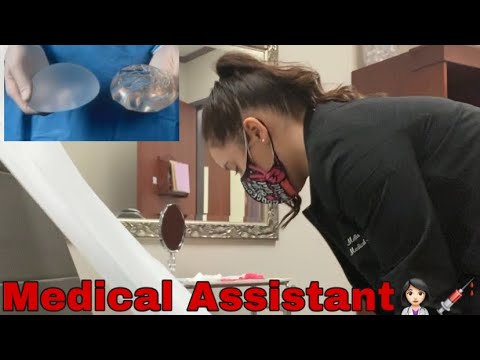What Does a Cosmetic Medical Assistant Do?
Contents
A Cosmetic medical assistant is responsible for providing support to the physician during cosmetic medical procedures. They may also be responsible for providing post-operative care to patients.
Checkout this video:
Job Description
The cosmetic medical assistant is responsible for providing patient care and administrative support to the physician in a cosmetic medical practice.
The medical assistant’s duties may include greeting and scheduling patients, verifying insurance coverage, taking medical histories and vital signs, updating patient records, preparing patients for examinations, assisting the physician during procedures, instructing patients on post-operative care, and handling laboratory specimens. The medical assistant may also be responsible for marketing tasks such as coordinating promotional events and developing marketing materials.
Duties and Responsibilities
A cosmetic medical assistant is responsible for performing a variety of tasks in a medical setting that relate to the care of patients undergoing cosmetic procedures. These procedures can include Botox injections, laser hair removal, and other types of skin treatments. The medical assistant may be responsible for preparing the treatment area, providing support to the patient during the procedure, and helping with post-procedure care. In some cases, the medical assistant may also be responsible for scheduling appointments and handling customer service inquiries.
Skills and Qualifications
Prospective cosmetic Medical assistants should have strong customer service skills to build relationships with patients. They should be comfortable multi-tasking and working in a fast-paced environment. Excellent written and verbal communication skills are essential, as well as good organizational skills and attention to detail.
Most employers require candidates to have at least a high school diploma, although some may prefer or require postsecondary education or a medical assistant certificate. Some states also require Medical Assistants to be licensed or certified.
Education and Training
Most employers prefer to hire candidates who have completed a postsecondary education program in medical assisting. such programs are typically offered at community colleges, technical institutes, and vocational schools. Some programs may last as little as 1 semester, but most medical assisting programs last 1 year or longer. Some medical assistants complete 2-year associate’s degree programs in medical assisting. Although not required, certification may improve job prospects.
Salary and Job Outlook
A cosmetic medical assistant is a health care professional who works in a medical office or clinic, assisting doctors and other staff with procedures and patient care. The average salary for a cosmetic medical assistant is $32,000 per year, and the job outlook is good, with an expected growth rate of 18% between 2018 and 2028.
Certification
A medical assistant specializing in cosmetics, also known as a cosmetic medical assistant, is a certified medical professional who works alongside licensed medical aestheticians and surgeons to provide pre- and post-operative patient care, help with administrative duties in a cosmetic medical practice, and perform minor cosmetic procedures. Along with a certification from an accredited institution, most states also require that cosmetic medical assistants complete a state-specific certifying exam.
Job Opportunities
A cosmetic medical assistant works in a medical office or clinic that provides cosmetic treatments. These treatments can include laser hair removal, Botox injections, and dermal fillers. The medical assistant will work closely with the cosmetic doctor or nurse to provide patients with the best possible care.
The duties of a cosmetic medical assistant include greeting patients, scheduling appointments, and preparing them for their procedure. The medical assistant will also perform basic office duties such as answering phones and filing patient records. Some cosmetic medical assistants are also responsible for helping to market the practice by handing out flyers and brochures.
Education requirements for a career as a cosmetic medical assistant vary by state, but most states require at least a high school diploma or equivalent. Some states also require certification from an accredited program. Many community colleges offer certification programs that teach the skills necessary to work as a medical assistant.
Advancement Opportunities
As a cosmetic medical assistant, you will have the opportunity to work with some of the most cutting-edge technologies and treatments in the cosmetic medical industry. You will also have the opportunity to work with a variety of patients, from those who are just beginning their journey to cosmetic enhancement to those who are long-time patients of the practice. In addition, you will have the opportunity to learn about and use a variety of products and treatments, from skincare and injectables to laser treatments and body contouring.
Pros and Cons
There are many different types of medical assistants, with different roles and responsibilities. Some work in hospitals, some in private clinics, and some in specialist practices such as cosmetic medicine. So, what does a cosmetic medical assistant do?
The role of a cosmetic medical assistant is to support the work of a cosmetic physician. This may involve carrying out basic treatments such as skin injections, assisting with surgery, or providing aftercare advice to patients.
Pros:
-Can learn a lot about the field of cosmetic medicine
-Can be very rewarding to help patients feel better about themselves
-May have opportunities to work with famous people or to travel
Cons:
-The work can be stressful and demanding
-May involve long hours and shift work
-The job may require working weekends and holidays
What Does a Cosmetic Medical Assistant Do?
A cosmetic medical assistant helps cosmetic surgeons with patient consultations, pre- and post-operative care, and related administrative tasks.
During patient consultations, the assistant gathered information about the patient’s medical history and current health condition. They also measured patients’ vital statistics, took photographs, and helped the surgeon assess whether the patient was a good candidate for the procedure.
After the consultation, the assistant helped schedule the surgery date and time, as well as any pre-operative appointments (such as lab work or x-rays). They also provided instructions to patients on how to prepare for surgery, such as what to eat or drink beforehand, and which medications to take or avoid.
On the day of surgery, the assistant met with the patient again to go over last-minute instructions. They also helped with pre-operative paperwork and escort patients into the operating room. During surgery, they assisted the surgeon by handing them instruments and supplies.
After surgery, they helped monitor patients’ vital signs and administered their post-operative medication. They also provided support and advice to patients as they recover from surgery.






